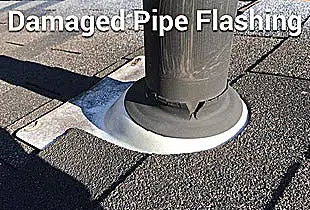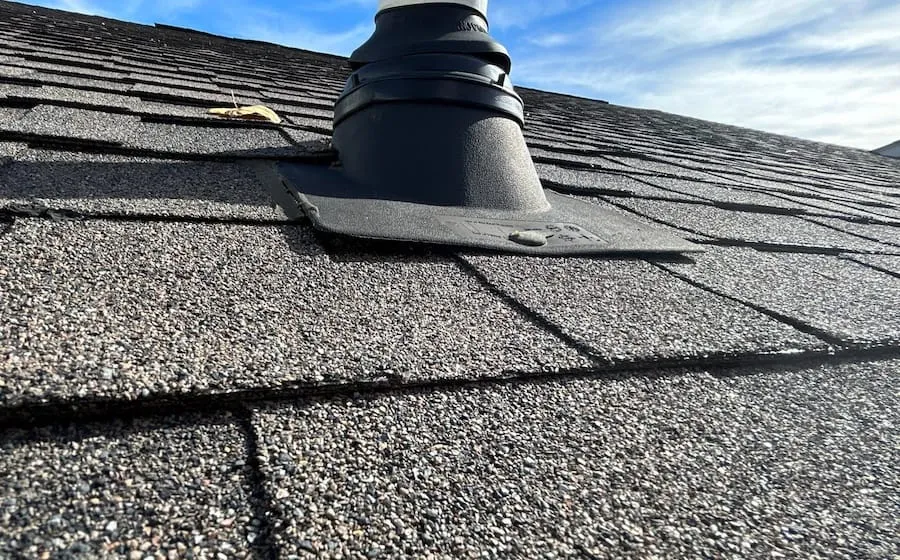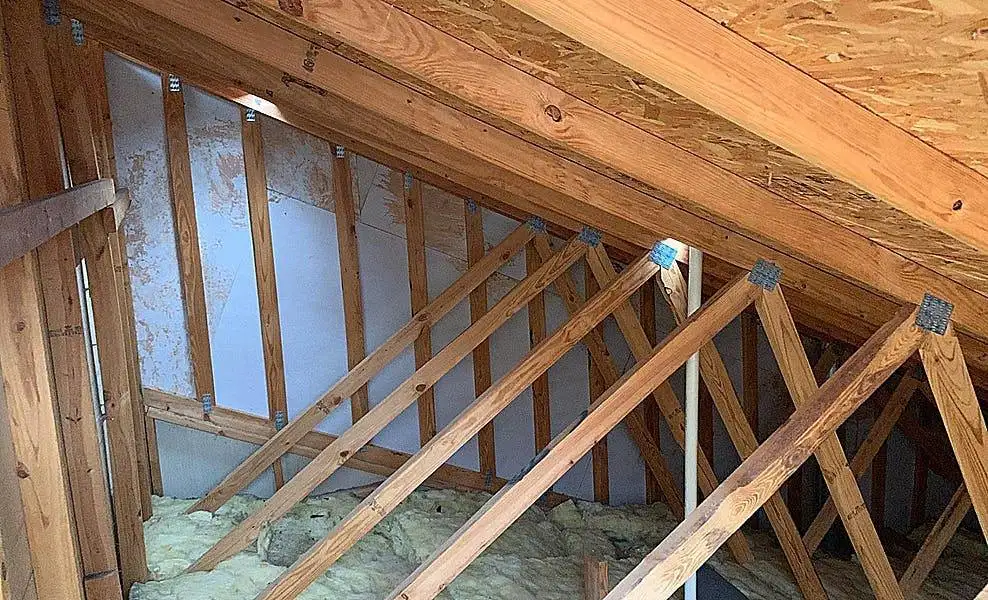A roof vent pipe that’s leaking can cause more than just a drip in your attic. These pipes are designed to help air flow through your plumbing system, but when the flashing, sealant, or vent boot fails, they can allow water straight into your home.
Even a small leak around a vent pipe can lead to stains on the ceiling, damp insulation, or mold in the attic. Catching the problem early helps protect your roof and prevent water damage from spreading.
Common Causes of a Roof Vent Pipe Leaking
Failing Flashing Around Roof Vents
Vent flashing seals the area where a roof vent exits the roof. Over time, exposure to the elements can cause it to crack, warp, or pull away from the shingles, breaking the watertight barrier. Once compromised, water can seep underneath, causing a vent leaking issue that enters the attic.

The rubber or metal boot around the vent base plays a critical role in this seal. Lower-quality boots often dry out and fail within 5–7 years, while premium ones can last decades. If the boot cracks or shifts, even slightly, leaks can begin almost immediately.
Poor Installation
Even premium flashing can fail when corners are cut during roofing work. Some contractors skip critical steps like applying sealant beneath roofing materials, omit ice and water shield underlayment in vulnerable areas, or leave fasteners exposed to the elements.

One common mistake is nailing through the bottom edge of the flashing and relying solely on caulk to seal the hole. But caulk, even high-quality caulk, typically lasts only 5 to 7 years before it dries, cracks, or pulls away. In some cases, it breaks down in as little as 4 years. Once the seal fails, water can sneak in from the sides or through the nail hole, bypassing the flashing entirely and creating a hidden entry point for moisture. Without proper layering and protection, the system cannot shed water the way it was designed to, and leaks often follow.
Pipe Location on the Roof
The placement of a roof vent also affects its long-term performance. Occasionally, a plumber or builder will position the vent in a risky location, such as the center of a roof valley where runoff naturally concentrates during storms. Even if the flashing and boot are installed correctly and sealed well, this location subjects the assembly to constant water flow. Over time, that steady exposure wears down seals, stresses joints, and increases the risk of leaks. Proper vent placement should account for roof slope, drainage paths, and weather exposure, because even the best materials can’t fully compensate for a poor location.

Inside the Attic
The source of a roof-related leak is not always visible from the outside. Inside the attic, plumbing vents often run through a series of PVC joints and directional changes. Over time, temperature shifts and building movement can cause these connections to loosen or develop tiny gaps.

Even a small separation may allow moisture, such as condensation or water that entered higher up, to drip into the attic space. When this happens, the issue may require two specialists: a plumber to assess and seal the interior pipe connections and a roofer to secure the exterior roof penetration. A full inspection from top to bottom ensures nothing is missed and the repair lasts.

Aging Sealant and Fasteners
Roofing sealants dry out and lose flexibility with age, while nails can rust, corrode, or gradually work their way loose. When this happens, tiny gaps form around the pipe base. These openings may seem minor, but they allow moisture to enter the roof system during wet weather. Over time, even occasional exposure can lead to hidden damage in the decking or attic insulation.
Signs Your Roof Vent Is Leaking
Over the years, we’ve walked into countless Maryland homes where the only clue to a failing roof vent was something subtle: a faint smell in the attic, a discolored patch on the ceiling, or peeling paint near the top of a wall.
We’ve seen brown water stains radiating from spots directly below roof vents. We’ve pulled back insulation in attics and found it damp, with that telltale musty odor following summer storms. On older homes, especially those with roofs over seven years old, we often find bubbling paint on upper walls, caused by slow, hidden moisture buildup.
In some cases, homeowners heard dripping in the attic long after the weather cleared. And yes, we’ve found visible mold growth or mildew clinging to rafters right around the pipe penetration, usually the final sign that a small issue had been ignored too long.
Every one of these signs tells a story. And in our experience, they almost always point back to a compromised roof vent. That’s why we always recommend a professional inspection before minor moisture turns into major damage.
Temporary Fixes for a Leaking Roof Pipe
If you’ve got a roof leak and your repair is still a few days away, you can slow things down, but don’t count on a quick patch to hold long.
We’ve seen customers throw a tarp over the affected area, stretching it snug over the pipe and the shingles around it, then weighing or tying it down securely. That can help keep rain water out during the next storm. Others have used roofing caulk to seal up gaps around the pipe base or cover exposed nail holes. It’s not pretty, but it can stop drips for a little while.
That said, we don’t recommend climbing up on your roof yourself. It’s easy to slip, even on a dry day, and the risk just isn’t worth it. If you need a temporary fix and aren’t comfortable on a ladder, call a professional roofer. Many of us, including our team at RoofPRO, will do a quick tarp or caulk job to get you through until the full repair can be done safely.
Remember, these are only short-term measures. A tarp can shift in the wind, and caulk breaks down faster than you’d think, sometimes in under a year. Until the boot and flashing are properly replaced and sealed, the leak will come back. So treat it like what it is: a temporary hold while you wait for the real fix.
Long-Term Solutions to Avoid Mold and Structural Damage
Replace the Vent Boot or Flashing
Remove the old, damaged boot or flashing and clean the area down to the roof deck. Install a new, high-quality boot or step flashing, making sure it’s properly integrated with the surrounding shingles and sealed at all edges.
Repair or Replace Nearby Shingles
Shingles around the pipe take a lot of wear. If they’re cracked, curled, or lifting, they won’t shed water properly. Replacing them ensures runoff flows away from the vent instead of seeping underneath.
Seal and Secure
After everything’s in place, apply roofing cement around the base of the vent and over all fasteners. This creates a flexible, waterproof seal that moves with the roof, not one that dries out and cracks in a couple of years.
Get a Warranty You Can Count On
Make sure your roofer provides a clear, written warranty on both materials and labor. A proper warranty means the repair is done right the first time, and if anything does go wrong down the road, you’re covered, not stuck with another costly fix.
RoofPRO: Maryland’s Trusted Roofing Experts Since 2004
RoofPRO has been helping Maryland homeowners stop roof vent leaks since 2004. Our certified team knows how to find the real source of the leak, whether it’s a cracked boot, bad flashing, or poor pipe placement.
We inspect everything from the shingles and underlayment to the attic and pipe joints, making sure the repair lasts. As a CertainTeed ShingleMaster-certified contractor, we use top-quality materials and proven repair methods backed by strong warranties.
If you’ve noticed stains, musty smells, or drips near your vent pipes, don’t wait until the damage spreads. Contact RoofPRO today for a free inspection and estimate from Maryland’s trusted leak repair experts.
Article Updated November 4, 2025.

Author Bio
Tim Taylor – Owner & Founder of RoofPRO
Tim Taylor began his roofing career in 2003 and founded RoofPRO in 2004 with a mission to fix the poor workmanship that often causes roof leaks. With over 20 years of hands-on experience, he’s earned elite credentials like CertainTeed’s ShingleMaster Wizard certification, HAAG inspection certifications, and OSHA safety training. His expertise in leak repair, flashing repair, and post-storm restoration has made RoofPRO one of Maryland’s most trusted roofing companies. Tim continues to lead with the same principle that built his reputation—roof it right the first time.



